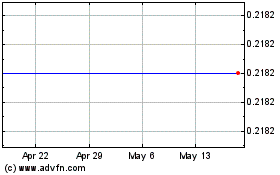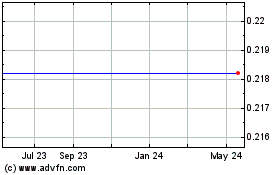Commtouch Releases Q2 Virus and Spam Statistics: Image Spam Causes Bandwidth Bloat; Also, Multi-Variant Viruses Elude Most Anti
July 12 2006 - 6:50AM
Business Wire
Attacks of image-based spam intensified in the second quarter of
2006, comprising 30 per cent of global spam on a single day,
Commtouch (NASDAQ:CTCH) reports. On days when image-based spam
achieves such a distribution peak, the global bandwidth and storage
consumed by spam grows by more than 70 per cent. "Image-based spam
may quickly cause IT resource overload if not dealt with properly,"
said Dan Yachin, Research Director EMEA Emerging Technologies at
IDC, a leading analyst firm. "While textual spam messages cause
loss of productivity, image spam messages that are three times
their size are a whole different ball game, causing a real
bandwidth and storage crisis." The cost of storage becomes a
crucial factor for large organizations that save all of their
email, especially in the age of the Sarbanes-Oxley Act and HIPAA
compliance. For companies that do not block image-based spam at the
perimeter, these bloated messages are often archived along with
legitimate business email. Image-based spam weighs in at an average
of 18 KB, more than three times the size of standard spam which
averages 5.5 KB. Image Spam Distribution: Comprising 30% of Global
Spam Image-based spam is a relatively new phenomenon, which
commenced in the third quarter of 2005. It consists of images only,
each of which contains tiny randomized changes to fool most
anti-spam filters; in addition, since these email messages contain
no text or URL hyperlinks, they are a challenge for many anti-spam
engines to block. Commtouch was one of the first vendors to
publicize a solution for blocking image-based spam, known as "Image
Spam Defense." Commtouch's Recurrent Pattern Detection(TM)
technology blocks spam without regard to the content of the
message. During the last half of Q2, image-based spam reached
distribution peaks around every two weeks, and diminished to just a
fraction of a percent of global spam during the troughs in between.
For example, on May 29, image-based spam was 30% of all global
spam, and on June 3 it was a negligible percent of global spam.
Commtouch calculated the following percentages of increased
bandwidth and storage necessary for spam, for the three latest
image-spam peaks in Q2: -0- *T Date Image Spam as Estimated percent
of Bandwidth Global Spam and Storage Increase -------------------
------------------- --------------- May 29, 2006 30% 70%
------------------- ------------------- --------------- June 10,
2006 22% 50% ------------------- -------------------
--------------- June 24, 2006 15% 35% -------------------
------------------- --------------- *T While the majority of
image-based spam deals with US-based penny stocks in traditional
"pump-and-dump" scams, the messages are distributed from all over
the world by vast "zombie" networks. Zombies or botnets are
typically home computers that have unknowingly been hijacked for
the use of spammers. End-users may not be aware that their computer
is being used as a pawn in the spam war, since the zombie only
activates itself at times when the user is not operating the
computer. Spam-sending zombie software can install itself on a
computer when a user clicks a hyperlink in a spam email, or opens a
malicious email attachment. "Our customers are pleased with
Commtouch's Image Spam Defense, which is integrated into our
Mailstream Manager," said Bernard Fraenkel, VP Engineering at
Sendmail, a Commtouch OEM partner. "While other companies'
employees complain about their inboxes overflowing with heavy,
annoying stock scams, our customers' users are not even aware that
an image-based spam attack took place." Virus Trends: Rapid Attacks
of Multiple Virus Variants While the first quarter of 2006 was
characterized by wave after wave of high intensity, massive email
borne virus attacks, the second quarter reflected a different
pattern: rapid attacks of multiple variations of the same virus.
Commtouch analysis has revealed that during Q2, email malware
writers have been distributing a growing number of variants for
each virus outbreak, all within a very short period of time. Such a
distribution pattern of multiple versions of the same virus family
ensures maximum evasion of signature-based or traditional
anti-virus engines. "Traditional AV solutions are powerless to
catch every variant of every virus family," said Amir Lev, CTO of
Commtouch. "Even if they catch the majority of viruses, some
hazardous variations can still penetrate if they do not exactly
match the heuristic rules set up to catch that virus family."
Commtouch's approach complements traditional, signature-based
anti-virus technology, and differs thoroughly in its method for
blocking viruses. Rather than trying to detect viral signatures,
Commtouch's RPD technology blocks viruses almost immediately after
they are distributed, based on identifying their distribution
patterns. Commtouch's Zero Hour(TM) Virus Protection OEM solution
has been adopted and implemented by leading AV vendors, including
F-Secure, Mirapoint, Tumbleweed, G-Data, and AhnLab in Korea. To
download a chart comparing the times various traditional AV vendors
caught particular virus variants, see
www.commtouch.com/viruscharts/June2006. Q2 2006: Major Spam
Categories & Countries Based on Commtouch's ongoing analysis of
billions of spam messages per month, at the end of the second
quarter, the major categories of spam were: -0- *T Spam Category
Percent of all global spam ------------------- ---------------
Pharmaceuticals 32% ------------------- --------------- Gifts 21%
------------------- --------------- Finance/Mortgage 11%
------------------- --------------- Pornography 9%
------------------- --------------- Enhancers 7%
------------------- --------------- *T Leading countries for
spam-origination were: -0- *T Country Percentage of spam
originating -------------------- -------------- United States
43.09% -------------------- -------------- China 10.17%
-------------------- -------------- Republic of Korea 3.83%
-------------------- -------------- Germany 3.49%
-------------------- -------------- Japan 3.10%
-------------------- -------------- *T Commtouch publishes regular
spam and virus trend reports based on email distribution patterns
gleaned from its global Detection Centers' analysis of over 2
billion messages per month. About Commtouch Commtouch Software Ltd.
(NASDAQ:CTCH) is dedicated to protecting and preserving the
integrity of the world's most important communications tool --
email. Commtouch has over 15 years of experience developing
messaging software and is a global developer and provider of
proprietary anti-spam and Zero-Hour virus protection solutions.
Using core technologies including RPD (Recurrent Pattern
Detection(TM)), the Commtouch Detection Center analyzes billions of
email messages per month to identify new spam and malware outbreaks
within minutes of their introduction into the Internet. Integrated
by more than 40 OEM partners, Commtouch technology protects
thousands of organizations, with over 35 million users in over 100
countries. Commtouch is headquartered in Netanya, Israel, and has a
subsidiary in Mountain View, CA. For more information, see:
www.commtouch.com, including the Commtouch online lab detailing
spam statistics and charts. About Sendmail Sendmail, Inc. is a
global provider of enterprise solutions for secure, dependable, and
compliant messaging. Sendmail solutions help organizations
eliminate unwanted messages, effectively manage their mail stream,
and address regulatory compliance and corporate governance
requirements. Customers across 33 countries and the majority of the
Fortune 1000, rely on Sendmail for their end-to-end email security
and infrastructure needs: gateway security, secure routing, policy
management, internal and outbound mail management, quarantine, and
email access and storage. Sendmail is headquartered in Emeryville,
CA, with offices and distributors in Europe, Asia, North and South
America. Visit www.sendmail.com or call 1-87-SENDMAIL.
CYREN (NASDAQ:CYRN)
Historical Stock Chart
From Jun 2024 to Jul 2024

CYREN (NASDAQ:CYRN)
Historical Stock Chart
From Jul 2023 to Jul 2024
